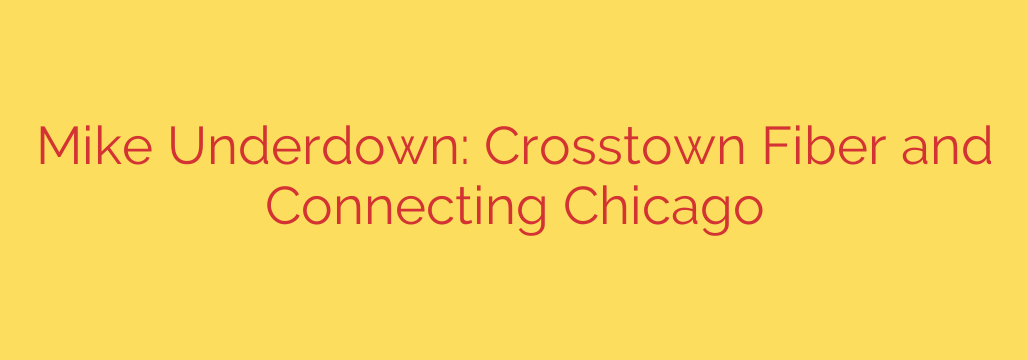
Unlocking Chicago’s Potential: The Mission to Bring City-Wide Fiber Internet
In an age where digital access is as essential as any other utility, the speed and reliability of your internet connection can define everything from economic opportunity to educational access. For a world-class city like Chicago, the digital infrastructure must be robust, competitive, and accessible to all. Yet, many residents and businesses remain underserved by legacy networks. A transformative new project is underway to change that reality by building a next-generation fiber optic network from the ground up.
At the heart of this initiative is a vision to permanently close Chicago’s digital divide and equip the city for the demands of the 21st century. The goal isn’t just to offer another internet option but to fundamentally reshape the digital landscape through a smarter, more equitable approach to connectivity.
The Problem: A Fractured Digital Landscape
For too long, Chicago’s internet market has been dominated by a few large providers, leaving many consumers with limited choices, asymmetrical speeds (fast downloads, very slow uploads), and inconsistent service. This lack of competition can lead to higher prices and slower innovation, impacting everyone from remote workers and students to small businesses and tech startups.
The challenge is to build an infrastructure that not only delivers incredible speed but also fosters a healthy, competitive market for internet services. This is where a new model for building fiber networks comes into play.
A New Foundation: The Open-Access Fiber Model
The strategy behind connecting Chicago is not simply to lay down cables and sell a service. Instead, the focus is on building an “open-access” fiber network.
What does this mean? Think of it like the city’s road system. The city builds and maintains the roads (the infrastructure), and any number of delivery companies—FedEx, UPS, local couriers—can use those roads to serve customers.
An open-access fiber network operates on the same principle:
- One Company Builds the Infrastructure: A single entity focuses on the expensive and complex task of building and maintaining the core fiber optic network.
- Multiple Providers Compete on the Network: Various Internet Service Providers (ISPs), both large and small, can then use this shared infrastructure to offer their services directly to consumers.
This model is a game-changer. By separating the infrastructure from the service, it dramatically lowers the barrier to entry for new ISPs, sparking genuine competition. For Chicagoans, this means more choices, better customer service, and more competitive pricing.
The Tangible Benefits of a True Fiber Network
A city-wide fiber network offers more than just faster movie streaming. It’s a foundational upgrade that impacts every aspect of urban life.
- Symmetrical Speeds: Unlike traditional cable internet, fiber offers symmetrical upload and download speeds. This is critical for modern internet use, including video conferencing, cloud file transfers, online gaming, and content creation.
- Unmatched Reliability: Fiber optic cables are more durable and less susceptible to weather-related outages or electrical interference than older copper or coaxial cables, resulting in a far more stable connection.
- Future-Proofing the City: A robust fiber network is an investment in Chicago’s future. It provides the bandwidth necessary to support emerging technologies like the Internet of Things (IoT), smart city applications, advanced telehealth, and innovations we haven’t even imagined yet.
- Economic Growth and Equity: High-speed, reliable internet access is a powerful engine for economic development. It attracts tech companies, empowers small businesses to compete globally, and provides equitable access to digital tools for education and employment in every neighborhood.
Actionable Tips: Preparing for Next-Generation Internet
As high-speed fiber becomes more widely available, you can take steps to ensure you’re ready to make the most of it.
- Check Your Internal Wiring: The fastest internet connection in the world can be bottlenecked by old or low-quality routers and Wi-Fi equipment. Consider upgrading to a Wi-Fi 6 or Wi-Fi 6E router to handle gigabit speeds throughout your home.
- Audit Your Speed Needs: Take stock of how many devices are connected in your home and what you use them for. A family with multiple remote workers, students, and gamers will benefit immensely from the capacity of a multi-gig fiber connection.
- Prioritize Network Security: A faster connection doesn’t automatically mean a more secure one. Ensure your router’s firmware is up-to-date, use a strong and unique password for your Wi-Fi network, and consider using a reputable VPN for an added layer of privacy.
The effort to build a comprehensive fiber network across Chicago is more than an infrastructure project; it’s a commitment to a more connected, competitive, and equitable future for all its residents. By laying the groundwork for true digital transformation, the city is positioning itself to lead and thrive for decades to come.
Source: https://datacenterpost.com/mike-underdown-on-building-crosstown-fiber-and-connecting-chicago/








